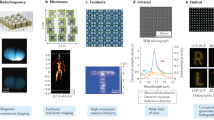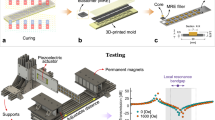Abstract
The study of advanced artificial electromagnetic materials, known as metamaterials, provides a link from material science to theoretical and applied electrodynamics, as well as to electrical engineering. Being initially intended mainly to achieve negative refraction1,2, the concept of metamaterials quickly covered a much broader range of applications, from microwaves to optics and even acoustics3,4. In particular, nonlinear metamaterials established a new research direction 5,6,7,8,9,10,11,12 giving rise to fruitful ideas for tunable and active artificial materials13,14,15. Here we introduce the concept of magnetoelastic metamaterials, where a new type of nonlinear response emerges from mutual interaction. This is achieved by providing a mechanical degree of freedom so that the electromagnetic interaction in the metamaterial lattice is coupled to elastic interaction. This enables the electromagnetically induced forces to change the metamaterial structure, dynamically tuning its effective properties. This concept leads to a new generation of metamaterials, and can be compared to such fundamental concepts of modern physics as optomechanics16 of photonic structures or magnetoelasticity in magnetic materials.
This is a preview of subscription content, access via your institution
Access options
Subscribe to this journal
Receive 12 print issues and online access
$259.00 per year
only $21.58 per issue
Buy this article
- Purchase on Springer Link
- Instant access to full article PDF
Prices may be subject to local taxes which are calculated during checkout





Similar content being viewed by others
References
Smith, D. R., Padilla, W. J., Vier, D. C., Nemat-Nasser, S. C. & Schultz, S. Composite medium with simultaneously negative permeability and permittivity. Phys. Rev. Lett. 84, 4184–4187 (2000).
Pendry, J. B. Electromagnetic materials enter the negative age. Phys. World 14, 47–51 (September, 2001).
Li, J. & Chan, C. T. Double-negative acoustic metamaterial. Phys. Rev. E 70, 055602 (2004).
Norris, A. N. Acoustic cloaking theory. Proc. R. Soc. A 464, 2411–2434 (2008).
Zharov, A. A., Shadrivov, I. V. & Kivshar, Y. S. Nonlinear properties of left-handed metamaterials. Phys. Rev. Lett. 91, 037401 (2003).
Lapine, M., Gorkunov, M. & Ringhofer, K. H. Nonlinearity of a metamaterial arising from diode insertions into resonant conductive elements. Phys. Rev. E 67, 065601 (2003).
Agranovich, V. M., Shen, Y. R., Baughman, R. H. & Zakhidov, A. A. Linear and nonlinear wave propagation in negative refraction metamaterials. Phys. Rev. B 69, 165112 (2004).
Scalora, M. et al. Generalized nonlinear Schrödinger equation for dispersive susceptibility and permeability: Application to negative index materials. Phys. Rev. Lett. 95, 013902 (2005).
Popov, A. K. & Shalaev, V. M. Compensating losses in negative-index metamaterials by optical parametric amplification. Opt. Lett. 31, 2169–2171 (2006).
Gabitov, I. R. et al. Double-resonant optical materials with embedded metal nanostructures. J. Opt. Soc. Am. B 23, 535–542 (2006).
Syms, R. R. A., Solymar, L. & Young, I. R. Three-frequency parametric amplification in magneto-inductive ring resonators. Metamaterials 2, 122–134 (2008).
Rose, A., Huang, D. & Smith, D.R. Controlling the second harmonic in a phase-matched negative-index metamaterial. Phys. Rev. Lett. 107, 063902 (2011).
Boardman, A. et al. Active and tunable metamaterials. Lasers Photon. Rev. 5, 287–307 (2011).
Chen, P-Y., Farhat, M. & Alú, A. Bistable and self-tunable negative-index metamaterial at optical frequencies. Phys. Rev. Lett. 106, 105503 (2011).
Ou, J. Y., Plum, E., Jiang, L. & Zheludev, N. I. Reconfigurable photonic metamaterials. Nano Lett. 11, 2142–2144 (2011).
Marquardt, F. & Girvin, S. M. Optomechanics. Physics 2, 40 (2009).
Kalinin, V. A. & Shtykov, V. V. On the possibility of reversing the front of radio waves in an artificial nonlinear medium. Sov. J. Commun. Technol. Electron. 36, 96–102 (1991).
Pendry, J. B., Holden, A. J., Robbins, D. J. & Stewart, W. J. Magnetism from conductors and enhanced nonlinear phenomena. IEEE Trans. Microw. Theory Tech. 47, 2075–2084 (1999).
Shamonina, E., Kalinin, V., Ringhofer, K. H. & Solymar, L. Magneto-inductive waveguide. Electron. Lett. 38, 371–373 (2002).
Gorkunov, M., Lapine, M., Shamonina, E. & Ringhofer, K. H. Effective magnetic properties of a composite material with circular conductive elements. Eur. Phys. J. B 28, 263–269 (2002).
Lapine, M. et al. Structural tunability in metamaterials. Appl. Phys. Lett. 95, 084105 (2009).
Powell, D. A., Lapine, M., Gorkunov, M., Shadrivov, I. V. & Kivshar, Y. S. Metamaterial tuning by manipulation of near-field interaction. Phys. Rev. B 82, 155128 (2010).
Tao, H. et al. Reconfigurable terahertz metamaterials. Phys. Rev. Lett. 103, 147401 (2009).
Zhao, R., Tassin, P., Koschny, T. & Soukoulis, C. Optical forces in nanowire pairs and metamaterials. Opt. Express 18, 25665–25676 (2010).
Perminov, S. V., Drachev, V. P. & Rautian, S. G. Optical bistability driven by the light-induced forces between metal nanoparticles. Opt. Letters 33, 2998–3000 (2008).
Marqués, R., Martín, F. & Sorolla, M. Metamaterials with Negative Parameters (Wiley, 2008).
Landau, L. D. & Lifschitz, E. M. Electrodynamics of Continuous Media (Pergamon Press, 1984).
Acknowledgements
This work was supported by the Australian Research Council. The authors thank M. Gorkunov and A. Sukhorukov for useful discussions.
Author information
Authors and Affiliations
Contributions
Theoretical analysis was carried out by M.L. and experiments were carried out by I.V.S. and D.A.P. All authors analysed and discussed the results. The manuscript was written by M.L., Y.S.K., D.A.P. and I.V.S. and the figures were prepared by I.V.S., D.A.P. and M.L.
Corresponding author
Ethics declarations
Competing interests
The authors declare no competing financial interests.
Rights and permissions
About this article
Cite this article
Lapine, M., Shadrivov, I., Powell, D. et al. Magnetoelastic metamaterials. Nature Mater 11, 30–33 (2012). https://doi.org/10.1038/nmat3168
Received:
Accepted:
Published:
Issue Date:
DOI: https://doi.org/10.1038/nmat3168
This article is cited by
-
Stress relaxation behavior of isotropic and anisotropic magnetorheological elastomers
Continuum Mechanics and Thermodynamics (2024)
-
Enhancing the magnetic response on polycrystalline nanoframes through mechanical deformation
Scientific Reports (2022)
-
In3SbTe2 as a programmable nanophotonics material platform for the infrared
Nature Communications (2021)
-
Integrating microsystems with metamaterials towards metadevices
Microsystems & Nanoengineering (2019)
-
Flexible controls of broadband electromagnetic wavefronts with a mechanically programmable metamaterial
Scientific Reports (2019)



